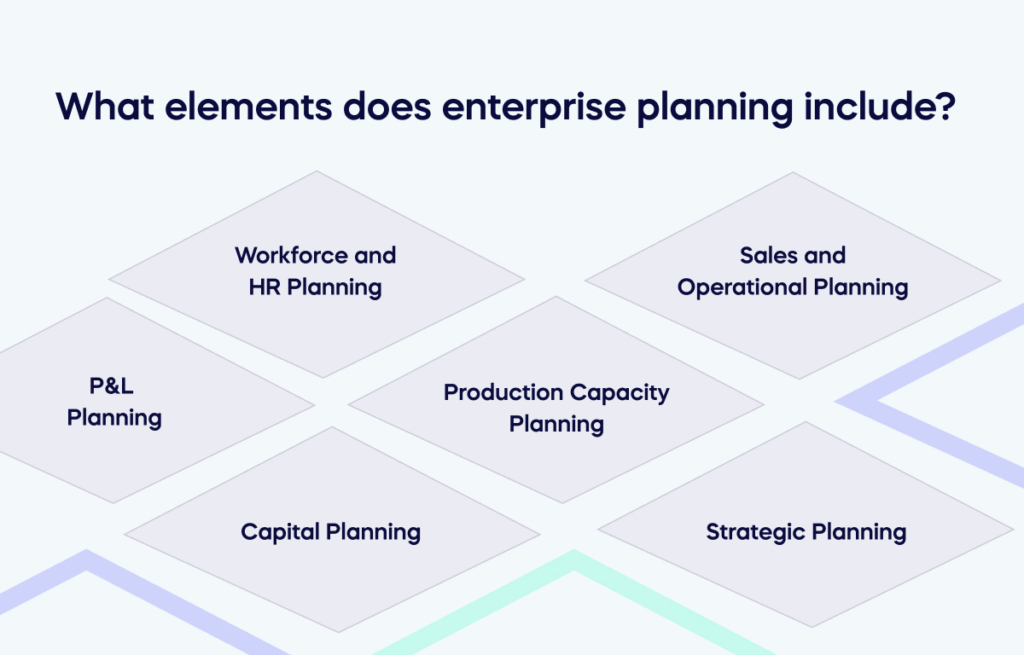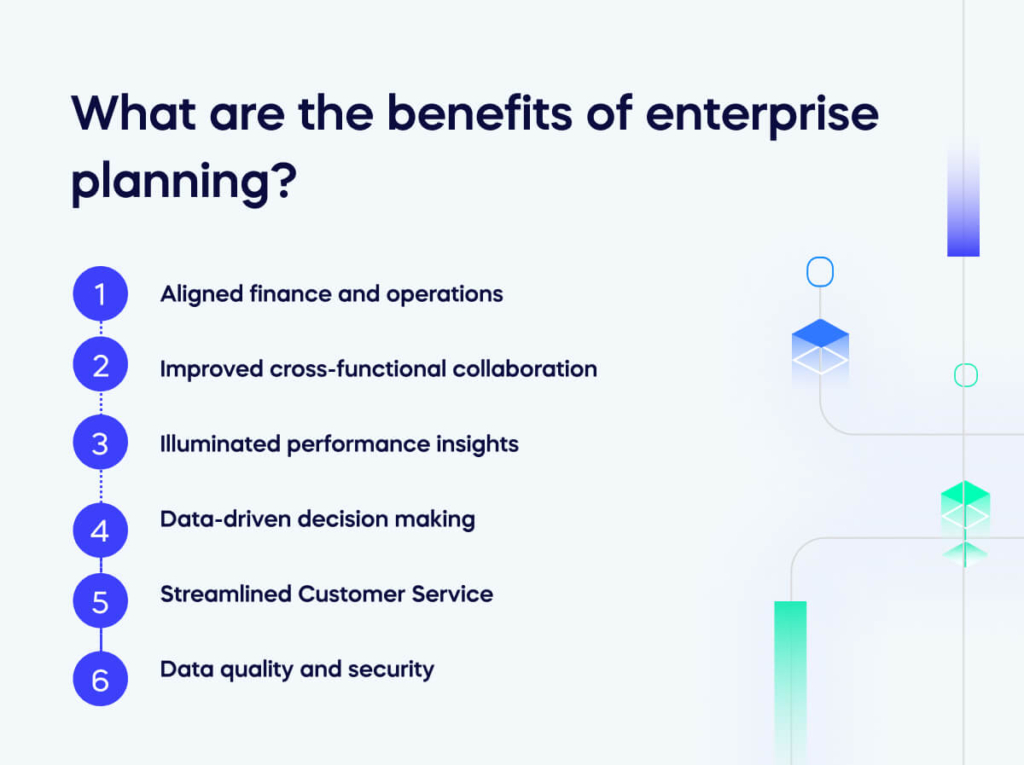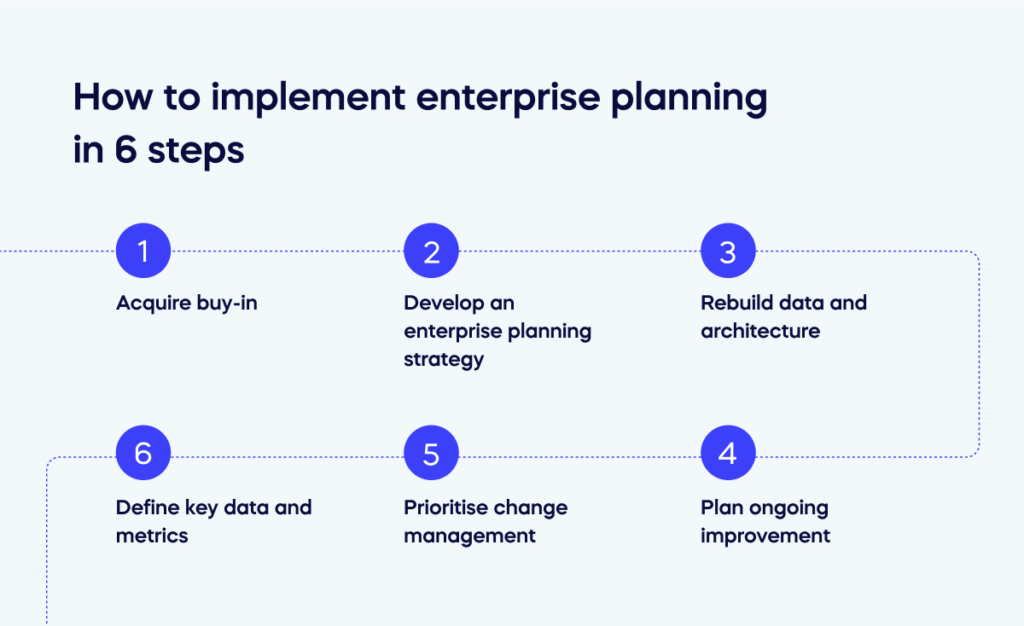Every year business planning gets more complicated. Emerging tech, complex staff needs, and significant financial pressures can make it feel like the pressure points will never end for the executive management. And in 2023, the impact of Covid-19 pandemic and the russia-ukraine war are taking their toll.
But relief is on the way. With the right strategic vision, enterprise planning holds all the answers to a well structured, successful organization. The industry is already recognizing the benefits of enterprise planning, with Gitnux reporting that the global ERP software market is likely to reach USD 100 billion by 2025.
The global success of the enterprise planning process comes from the fact that it encompasses all the planning areas. It therefore has the outcome of an organized and successfully acquire a competitive advantage throughout this entire process.
To help you understand enterprise planning and how to plan in 2023, we will cover the following topics:
- What is the purpose of enterprise planning in 2023?
- What elements does enterprise planning include?
- What are the benefits of enterprise planning?
- How to implement enterprise planning in 6 steps
What is the purpose of enterprise planning in 2023?
The purpose of enterprise management, also called comprehensive planning or analysis planning, in 2023 is to enable you to control, balance and align your company goals via your organization’s management and capabilities and financial objectives.
You can achieve this using an Enterprise Management System (EMS), sometimes called Enterprise System.
These are software packages that support your organizations to manage several software tasks at once, completing and improving business processes, and can include ERP (enterprise resource planning) resource allocation software.
If you’d like a visual representation of the purpose of enterprise planning in 2023, click on the three-minute video below.
QueBIT – Extended Planning and Analysis (xP&A)
What elements does enterprise planning include?

To help frame enterprise planning in the context of 2023, let’s look at its core functions via the different sub-types of planning that fall under the enterprise planning umbrella.
The first of these planning types is P&L (profit and loss) planning, as seen below:
- P&L Planning: Enterprise management should be the core of your financial planning efforts, as it involves allocating resources and how this relates to your company goals.
- Workforce and HR Planning: People are resources, and enterprise management helps you decide who is needed for which area of the organization.
- Capital Planning: Enterprise management helps you to see where you must allocate capital for the best return.
- Production Capacity Planning: Knowing the production capacity can assist you in making the most of resources, cutting costs, and detecting potential issues using market research.
- Sales and Operational Planning: S&OP (sales and operations planning) is a planning process that integrates demand, supply, and financial planning.
- Strategic Planning: Get an overarching view of your goals and the strategy to achieve them with enterprise planning.
It is helpful to be aware of the functions of enterprise planning to ensure you optimize its use within your organization.
What are the benefits of enterprise planning?

There are many benefits of enterprise planning, and being aware of them helps ensure you get the most out of any enterprise planning strategy.
Aligned finance and operations
Enterprise planning lets planners see the cause-and-effect relationship between operational and financial data. This gives planners more visibility into resource requirements to enable optimum business performance.
Improved cross-functional collaboration
When organizations plan by department, plans are typically siloed from one another. All departments plan with other departments in mind by instituting a cohesive planning process across the organization.
This awareness results in a more strategic operational approach which considers financial results and more effective performance improvement and management.
Illuminated performance insights
Many companies limit the planning function by relegating planning tools to finance and finance alone. But organizations can potentially align their entire business by deploying an enterprise planning strategy using key performance indicators (KPIs).
To get the best performance insights on training progress as your staff learn how to use enterprise planning tools, implement our DAP (digital adoption platform).
It’s in-app guidance and personalized learning can drive and illuminate performance throughout your enterprise planning strategy.
When all planning functions are connected enterprise-wide, planners from every department can determine goals and create budgets and plans that consider all facets of the organization.
Data-driven decision making
Enterprise planning systems elevate planners’ analysis by democratizing relevant information across departments.
With the ability to sift and sort enterprise data according to various drivers, planners can understand the root cause of performance, which enables them to either take action or change course.
Streamlined Customer Service
Even if your company’s clients are unaware of it, they also enjoy the advantages of the enterprise planning system.
The system centralizes and simplifies client information, freeing your sales team to focus on building and sustaining customer relationships rather than managing spreadsheets. Ultimately, customer acquisition and retention are paramount concerns for any business.
Data quality and security
Enterprise planning systems bring the advantage of improved data security since they focus on managing data and offer sharing capabilities across different departments, such as sales and marketing.
This collaboration enhances employee productivity. However, enterprise planning solutions also provide control mechanisms to ensure only authorized person access and edit the data.
How to implement enterprise planning in 6 steps

Expanding planning and analysis beyond the finance function to include planning processes, data, and tools requires careful strategies and consideration, even if it may seem like a natural progression for enterprise planning processes.
To increase the chances of successfully adopting enterprise planning across the business by including all internal and external factors, follow the steps outlined below:
1. Acquire buy-in
To implement enterprise planning, it is crucial to have backing from the executive team and departmental leaders. The finance team needs to ensure that everyone comprehends their responsibilities in these upgraded procedures and the advantages that enterprise planning can offer them.
2. Develop an enterprise planning strategy
The finance department needs to plan how to roll out FP&A to all departments in the business. Additionally, it should develop a strategy for continuous planning and performance management that considers the views of critical stakeholders.
3. Rebuild data and architecture
To fully achieve xP&A goals, simply transferring current systems may not be sufficient. Identifying what digital tools and capabilities are necessary to enable xP&A goals and ensure data integrity.
Integration of all relevant business data in one platform will require changes in architecture and increased data management requirements.
4. Define key data and metrics
The finance department can collaborate with other departments and business units to determine the most crucial operational and financial performance data, identify potential changes, and decide which metrics should be included in xP&A.
5. Prioritise change management
It’s vital for everyone involved, including executives, board members, managers, users, and the IT department, to make changes when implementing xP&A.
To ensure a successful deployment, it’s crucial to prioritize change management and clear communication throughout the process.
6. Plan ongoing improvement
Over time, xP&A processes can be improved and expanded. Organizations should consider adopting a test-and-learn approach to successfully implement xP&A in different functions, geographic locations, or business units.
Streamline your enterprise planning with a DAP
Enterprise planning is vital for businesses seeking to elevate their operations. By embracing strategic thinking, data-driven insights, and efficient decision-making, organizations can confidently navigate the complexities of a rapidly evolving market.
However, to truly unlock the full potential of enterprise planning, it’s crucial to leverage modern technologies that simplify and streamline the process. That’s where a DAP comes into play.
With its advanced features and capabilities, a DAP empowers businesses to optimize their enterprise planning projects, enabling seamless collaboration, real-time data analysis, and informed decision-making.
Don’t wait any longer; take the leap and use a DAP to streamline your enterprise planning project today. Witness firsthand the transformative impact it can have on your business’s growth and success.


